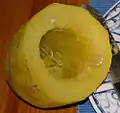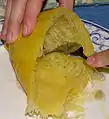Spaghetti squash
Spaghetti squash or vegetable spaghetti is a group of cultivars of Cucurbita pepo subsp. pepo.[1] They are available in a variety of shapes, sizes, and colours, including ivory, yellow and orange, with orange having the highest amount of carotene. Its center contains many large seeds. When raw, the flesh is solid and similar to other raw squash. When cooked, the meat of the fruit falls away from the flesh in ribbons or strands that look like, and are often used as a healthier alternative to, spaghetti.
| Spaghetti squash | |
|---|---|
 Fruit of a yellow-skinned cultivar | |
| Species | Cucurbita pepo |
| Origin | North America and Central America |
| Nutritional value per 100 g (3.5 oz) | |
|---|---|
| Energy | 130 kJ (31 kcal) |
6.91 g | |
| Sugars | 2.76 g |
| Dietary fiber | 1.5 g |
0.57 g | |
0.64 g | |
| Vitamins | Quantity %DV† |
| Vitamin A equiv. | 1% 6 μg1% 64 μg |
| Thiamine (B1) | 3% 0.037 mg |
| Riboflavin (B2) | 2% 0.018 mg |
| Niacin (B3) | 6% 0.95 mg |
| Pantothenic acid (B5) | 7% 0.36 mg |
| Vitamin B6 | 8% 0.101 mg |
| Folate (B9) | 3% 12 μg |
| Vitamin C | 3% 2.1 mg |
| Vitamin E | 1% 0.13 mg |
| Minerals | Quantity %DV† |
| Calcium | 2% 23 mg |
| Iron | 2% 0.31 mg |
| Magnesium | 3% 12 mg |
| Manganese | 6% 0.125 mg |
| Phosphorus | 2% 12 mg |
| Potassium | 2% 108 mg |
| Zinc | 2% 0.19 mg |
| |
| †Percentages are roughly approximated using US recommendations for adults. Source: USDA FoodData Central | |
Preparation
Spaghetti squash can be cooked in a variety of ways, including baking, boiling, steaming, or microwaving.[2] Once cooked the flesh of this fruit can be prepared in a way that its “strands” look like and are as long as traditional spaghetti noodles.[3] It can be served with or without sauce as a substitute for pasta, and its seeds can be roasted, similar to pumpkin seeds.
Nutrition
Spaghetti squash contains many nutrients, including folic acid, potassium, vitamin A, and beta carotene. It is low in calories, averaging 42 calories per 1-cup (155 grams) serving.[4]
Cultivation

Spaghetti squash is relatively easy to grow, thriving in gardens or pots.[5]
The plants are monoecious, with male and female flowers on the same plant.[6] Male flowers have long, thin stems that extend upwards from the vine. Female flowers are shorter, with a small round growth underneath the petals. This round growth turns into the squash if the flower is successfully pollinated.
Spaghetti squash plants may cross-pollinate with zucchini plants.
 Cooked
Cooked Prepared
Prepared Male flower
Male flower Female flower
Female flower Being sold at a Greengrocer in Japan
Being sold at a Greengrocer in Japan Served with marinara sauce
Served with marinara sauce
References
- "Cucurbita pepo". Germplasm Resources Information Network (GRIN). Agricultural Research Service (ARS), United States Department of Agriculture (USDA). Retrieved 2015-01-31.
- How to Cook Spaghetti Squash
- "How to Cook Spaghetti Squash | Eat Within Your Means". Eat Within Your Means. 2017-01-17. Retrieved 2017-11-19.
- Squash, winter, spaghetti, cooked, boiled, drained, or baked, without salt
- Liz Roberts. "Spaghetti squash: a vegetable with a surprise inside". AllWoodWork.com. Archived from the original on 2012-02-16.
- A Short Essay on Spaghetti Squash
External links
| Wikibooks Cookbook has a recipe/module on |
- A.H. Beany; P.J. Stoffella; N. Roe; D.H. Picha (2002). "Production, fruit quality, and nutritional value of spaghetti squash". In J. Janick; A. Whipkey (eds.). Trends in new crops and new uses. Alexandria, VA: ASHS Press. pp. 445–448.
